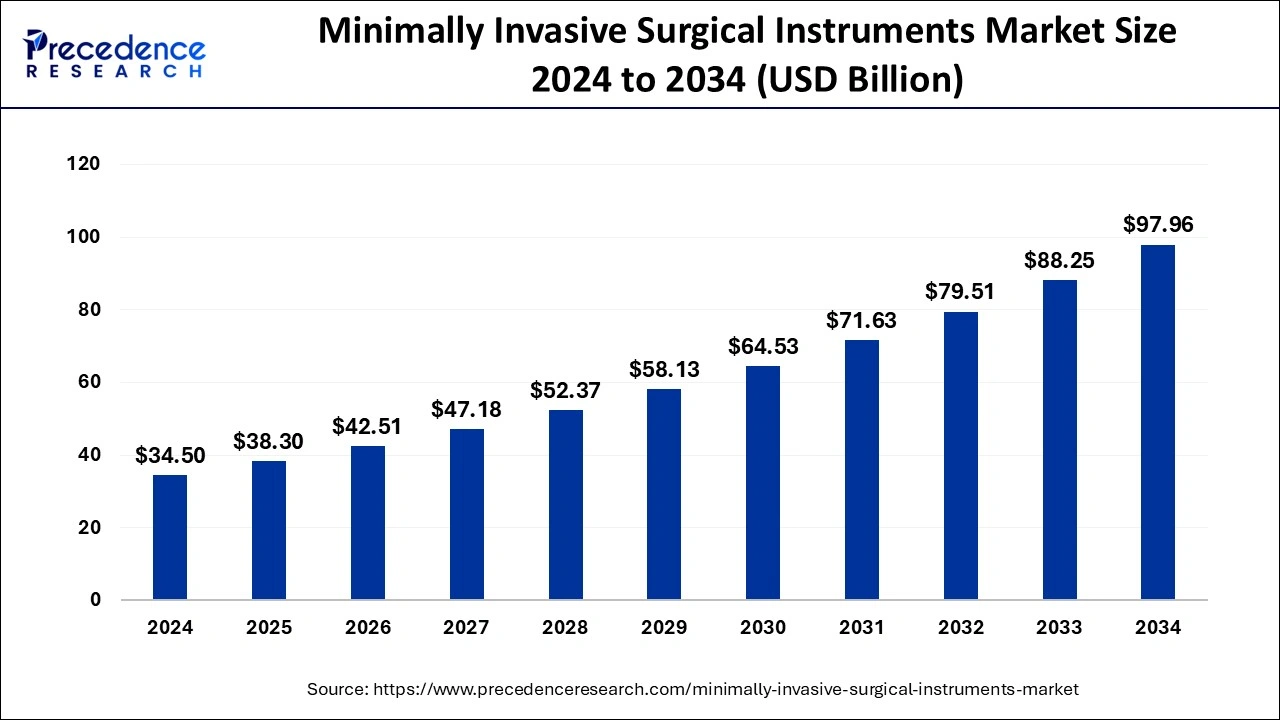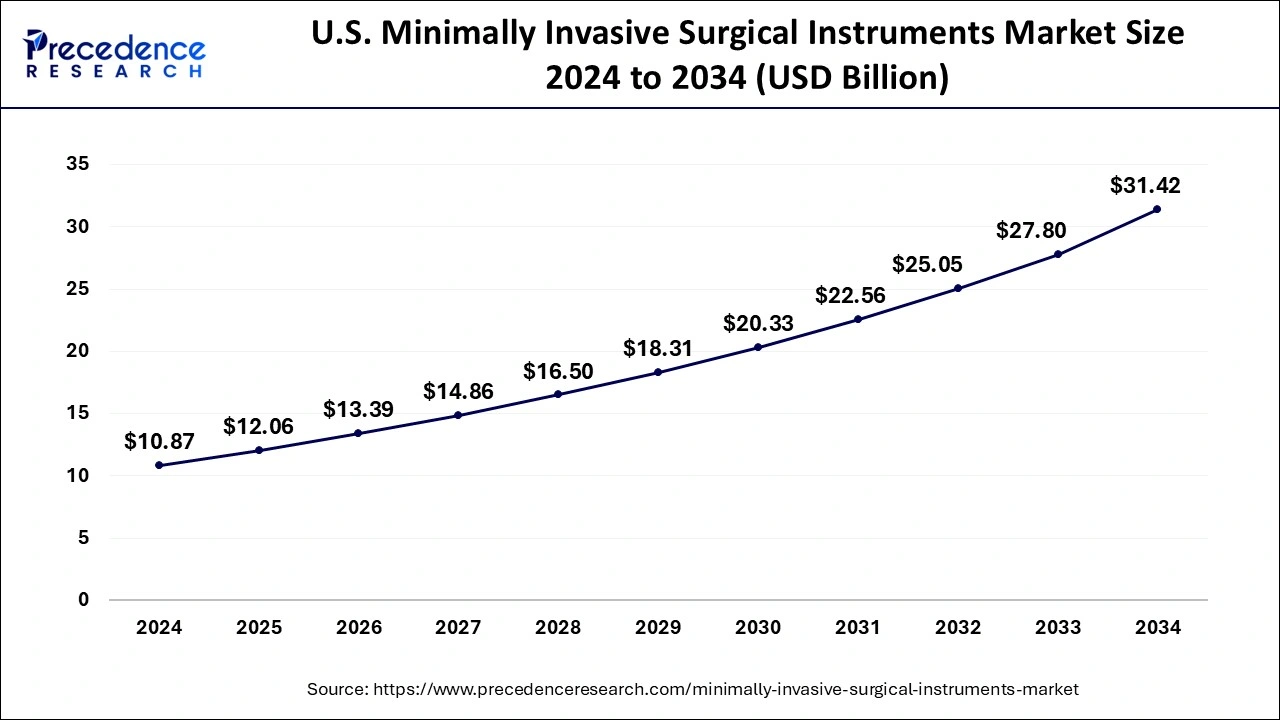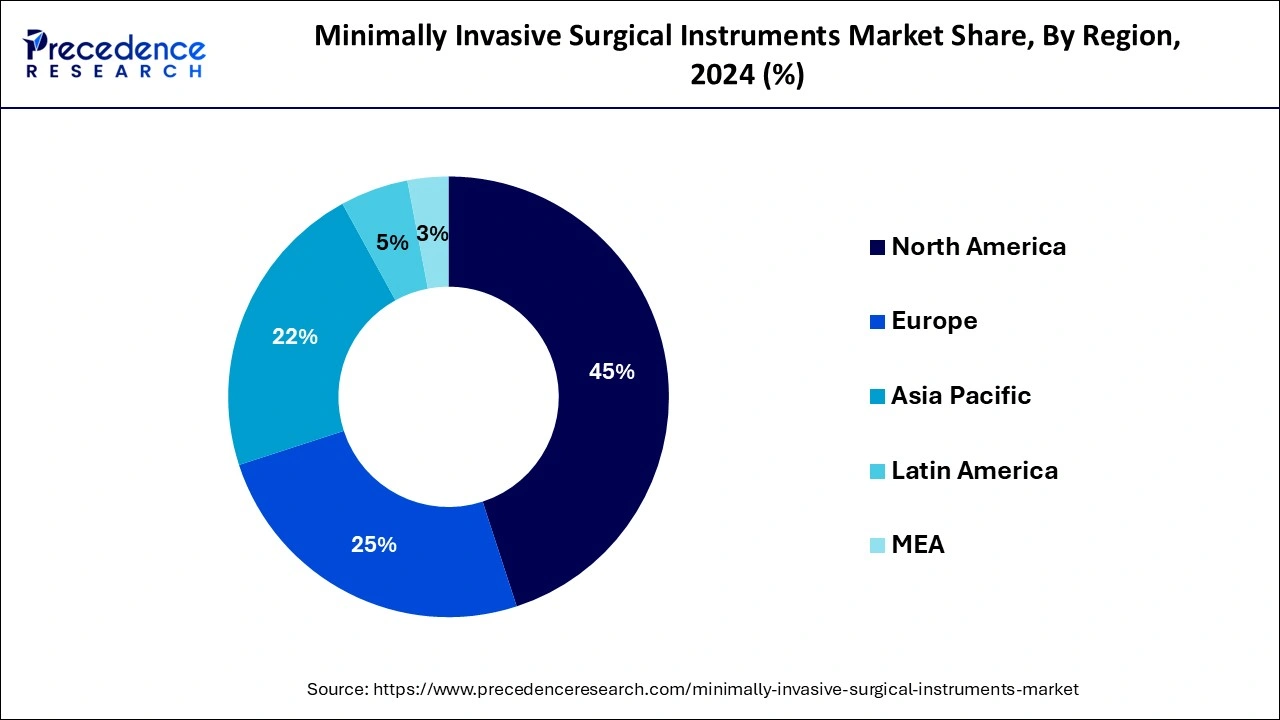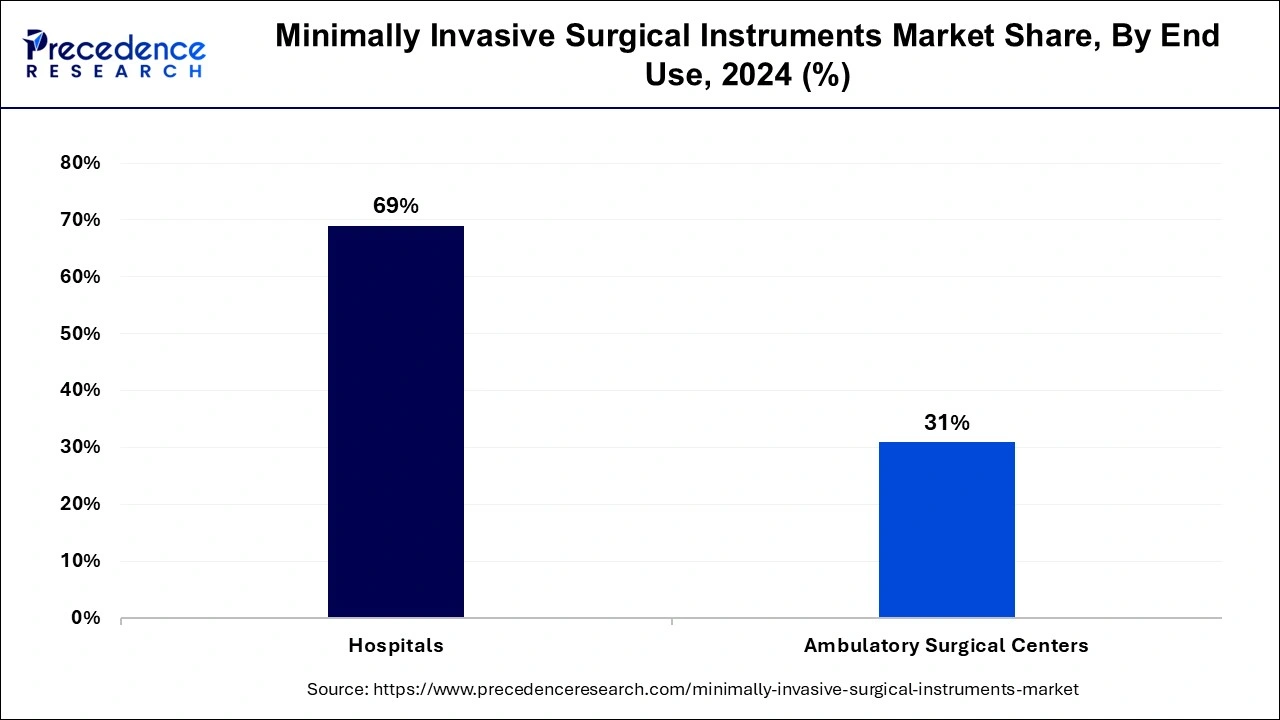February 2025
The global minimally invasive surgical instruments market size was accounted for USD 34.50 billion in 2024, grew to USD 38.30 billion in 2025 and is predicted to surpass around USD 97.96 billion by 2034, representing a healthy CAGR of 11% between 2025 and 2034. The North America minimally invasive surgical instruments market size was calculated at USD 15.53 billion in 2024 and is expected to grow at a fastest CAGR of 11.12% during the forecast year.
The global minimally invasive surgical instruments market size was estimated at USD 34.50 billion in 2024 and is anticipated to reach around USD 97.96 billion by 2034, expanding at a CAGR of 11% from 2025 to 2034. Factors such as increasing awareness regarding the benefits of minimally invasive surgical procedures, rising R&D expenditure, and a surge in the cases of lifestyle-related and chronic disorders are some of the major factors driving the growth of the global minimally invasive surgical instruments market in the coming years.

Over the years, Artificial Intelligence (AI) integration has significantly reshaped the landscape of the medical devices industry. As AI continues to evolve, its role in minimally invasive surgical instruments is likely to expand. Artificial Intelligence (AI) integration assists in designing minimally invasive surgical instruments to perform minimally invasive surgeries. The integration of AI provides real-time data analysis and assists surgeons in avoiding obstacles during surgery as well as warns of potential complications during a minimally invasive procedure. The technological improvements in minimally invasive surgical instruments assist surgeons in increasingly complex procedures. AI also plays a vital role in surgeries by providing support through interpreting digital visual information displayed on monitors. This directly aids surgeons in the intraoperative decision-making process. Therefore, the Artificial Intelligence (AI) integration has led to an increase in the overall efficiency of the minimally invasive surgical instruments market.
The U.S. minimally invasive surgical instruments market size was evaluated at USD 10.87 billion in 2024 and is predicted to be worth around USD 31.42 billion by 2034, rising at a CAGR of 11.20% from 2025 to 2034.

North America led the market in 2024 with revenue share of 45%. The minimally invasive surgical instruments market in this region is expanding due to the growing prevalence of various kind of disorders. Heart disease is the biggest cause of mortality in the U.S. as per an updated report published by the Centers for Disease Control and Prevention in September 2022. About 18.2 million American adults aged 20 and above have coronary artery disease and approximately 360,900 people died from coronary heart disorder in 2019. In addition, adoption of innovative technologies is also driving the growth of minimally invasive surgical instruments market in North America region.

Asia-Pacific, on the other hand, is expected to develop at the fastest rate during the forecast period. China and Japan dominate the minimally invasive surgical instruments market in Asia-Pacific region. The factors such as rapid urbanization, growing geriatric population, and growing trend of medical tourism are boosting the growth of minimally invasive surgical instruments market in this region. In addition, the increase in healthcare expenditure is paving way for the expansion of Asia-Pacific minimally invasive surgical instruments market.
Minimally invasive surgeries are surgeries that are done using small incisions and a few stitches. During minimally invasive surgery, one or more small incisions are generally made on the patient’s body. Minimally invasive surgeries cause less pain, reduce the damage to healthy tissue, and enable faster recovery of patients than with traditional surgery. Minimally invasive surgical instruments include a laparoscope which is a thin and tube-like instrument inserted through one opening to guide the surgery. Tiny surgical instruments are inserted through other openings to operate the surgery efficiently.
How Artificial Intelligence (AI) integration is impacting the growth of the minimally invasive surgeries?
Over the years, Artificial Intelligence (AI) integration has significantly reshaped the landscape of the medical devices industry. As AI continues to evolve, its role in minimally invasive surgical instruments is likely to expand. Artificial Intelligence (AI) integration assists in designing minimally invasive surgical instruments to perform minimally invasive surgeries. The integration of AI provides real-time data analysis and assists surgeons in avoiding obstacles during surgery as well as warns of potential complications during a minimally invasive procedure. The technological improvements in minimally invasive surgical instruments assist surgeons in increasingly complex procedures. AI also plays a vital role in surgeries by providing support through interpreting digital visual information displayed on monitors. This directly aids surgeons in the intraoperative decision-making process. Therefore, the Artificial Intelligence (AI) integration has led to an increase in the overall efficiency of the minimally invasive surgical instruments market.
| Report Coverage | Details |
| Market Size in 2024 | USD 34.50 Billion |
| Market Size in 2025 | USD 38.30 Billion |
| Market Size by 2034 | USD 97.96 Billion |
| Growth Rate from 2025 to 2034 | CAGR of 11% |
| Base Year | 2024 |
| Forecast Period | 2025 to 2034 |
| Segments Covered | By Device, By Application, and By End Use |
| Regions Covered | North America, Europe, Asia-Pacific, Latin America, and Middle East & Africa |
Rising acceptance rate of minimally invasive surgeries over traditional surgeries
The increasing demand for minimally invasive surgeries over traditional surgeries is expected to boost the demand for minimally invasive surgical instruments during the forecast period. Minimally invasive surgery widely known as laparoscopic or keyhole surgery, involves performing surgical procedures through small incisions rather than large open incisions. Minimally invasive surgical instruments are used to treat chronic disorders including urological, gynecological, gastrointestinal, and others. Minimally invasive procedures offer several benefits over conventional open surgeries such as shortened hospital time, reduced trauma, less scar, minimizes the chance of infection, faster recovery times, and fewer post-operative complications. Such factors are driving the growth of the minimally invasive surgical instruments market in the coming years.
Shortage of Skilled Professionals
The shortage of skilled professionals is anticipated to hamper the growth of the market. Several middle- and lower-income countries lack suitable healthcare infrastructure and experienced healthcare professionals to perform minimally invasive surgeries, impacts the overall growth of the market. In addition, high cost associated with technological advanced instrument manufacturing may restrict the expansion of the global minimally invasive surgical instruments market during the forecast period.
Rapid Technological innovations
The rapid technological innovations are projected to offer lucrative growth opportunities to the minimally invasive surgical instruments market. Several market players in the market are continuously focusing on developing technological surgical instruments including the development of miniaturized devices, advanced imaging technologies, and robotic-assisted systems. In addition, the rise in the adoption of marketing strategies by prominent market players such as new product launches, mergers, collaborations, and acquisitions to gain a competitive edge in the global minimally invasive surgical instruments market in the coming years. For instance, In September 2024, Arthrex, a global leader in minimally invasive surgical technology and medical education, announced the release of OrthoPedia Patient, an interactive digital platform that provides patients with access to easy-to-understand videos covering a comprehensive range of orthopedic conditions and treatments.
The handheld instruments segment accounted for the largest revenue share in 2024. The handheld instruments segment is growing due to technological developments especially due to adoption of robotics. These minimally invasive surgical instruments are cost effective when compared to other types of minimally invasive surgical instruments. In addition, handheld instruments are easy to operate. All of these aforementioned factors are driving the growth of the segment.
The electrosurgical devices segment is expected to witness strong growth during forecast period. Due to rising frequency of chronic disorders, the ageing population, and the rise in the number of minimally invasive surgical processes, the electrosurgical devices segment is predicted to grow fast throughout the projected period. The demand for cosmetic operations is growing and one key driver driving demand and acceptance of electrosurgical devices in the global market is the rising use of electrosurgical devices in minimally invasive cosmetic surgeries.
The orthopedic segment dominated the market in 2024. The orthopedic minimally invasive surgical processes are quite less risky as compared to traditional surgical methods. As a result, minimally invasive surgical instruments are used in critical orthopedic operations. Due to these factors, minimally invasive surgical instruments are highly adopted by surgeons and orthopedic surgeons.
The cardiac surgery segment is projected to hit strong growth from 2025 to 2034. The minimally invasive operations have a number of advantages over traditional surgeries including less pain and blood loss. In addition, the growing prevalence of cardiovascular disorders is considered as key factor driving the demand for minimally invasive surgical instruments for cardiac surgery.
The hospital segment accounted revenue share of around 69% in 2024. The market for minimally invasive surgical instruments is expanding due to growing number of hospitals globally. Moreover, the government all around the globe is taking efforts for the development of healthcare facilities. In addition, the rising prevalence of chronic disorders are also contributing towards the growth of the segment.

The ambulatory surgical centers segment is expected to hit remarkable growth during the forecast period. The growing number of ambulatory surgical centers is driving the growth of global minimally invasive surgical instruments market. As per the government records, there are 5,500 ambulatory surgical centers in the U.S. The ambulatory surgical centers are considered as cost effective option as compared to hospitals. The favorable reimbursement policies is driving the adoption of minimally invasive surgical instruments in ambulatory surgical centers on a large scale.
By Device
By Application
By End Use
By Geography
For inquiries regarding discounts, bulk purchases, or customization requests, please contact us at sales@precedenceresearch.com
No cookie-cutter, only authentic analysis – take the 1st step to become a Precedence Research client
February 2025
August 2024
October 2024
March 2025